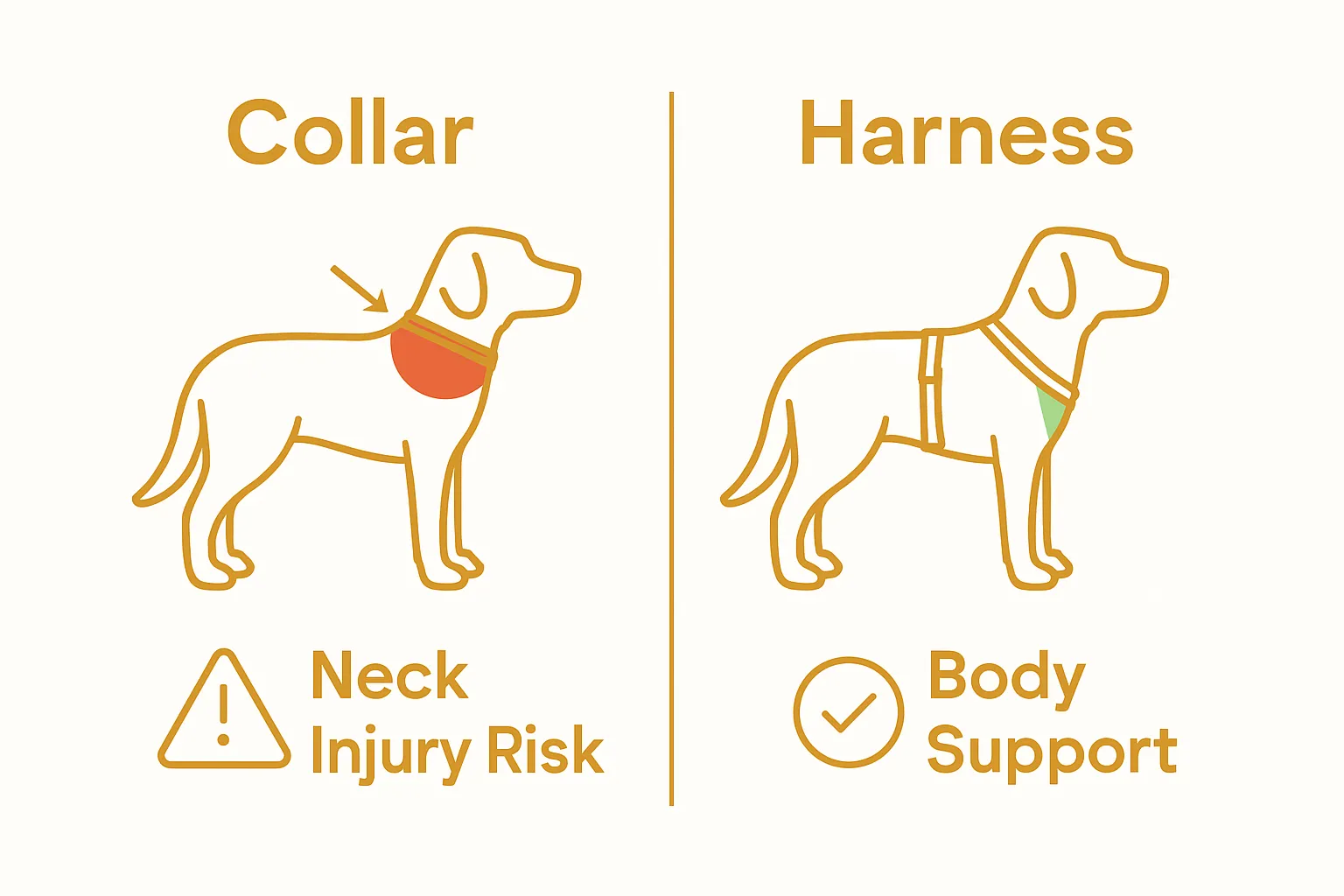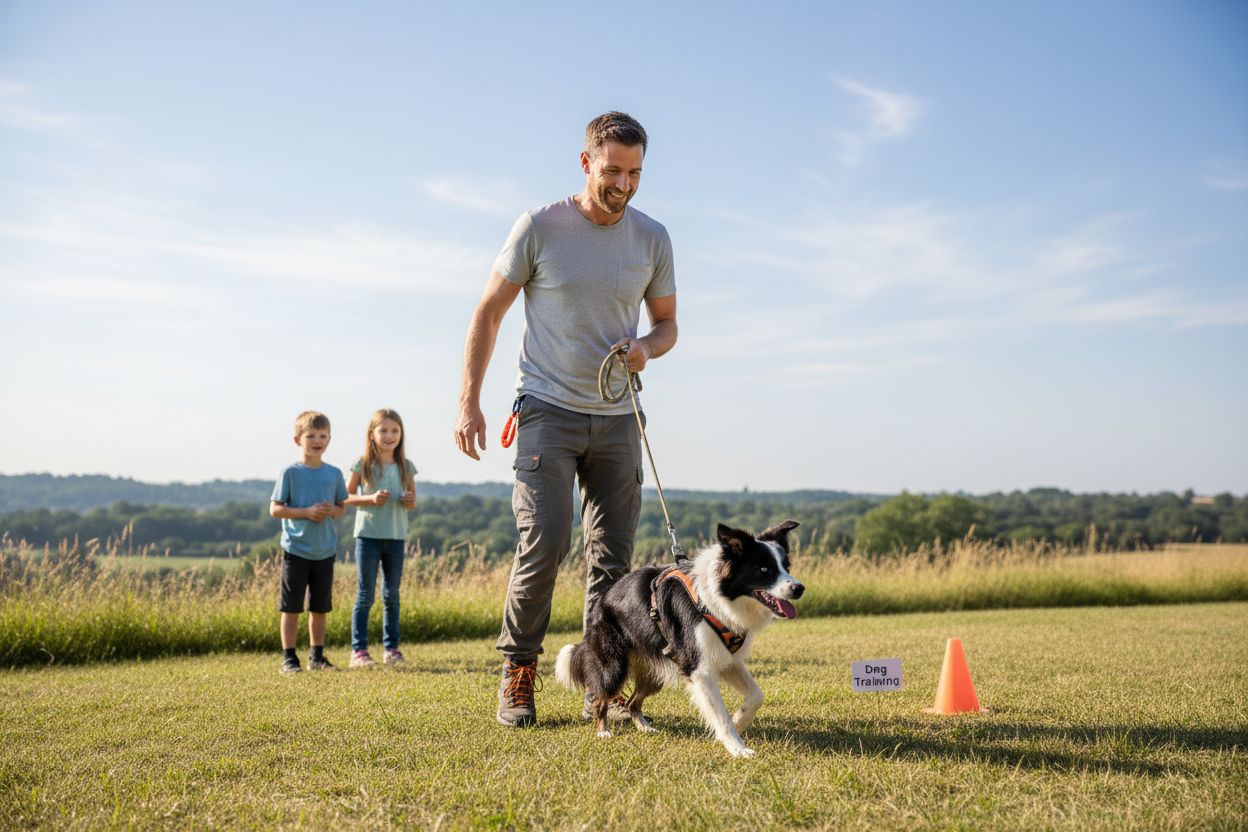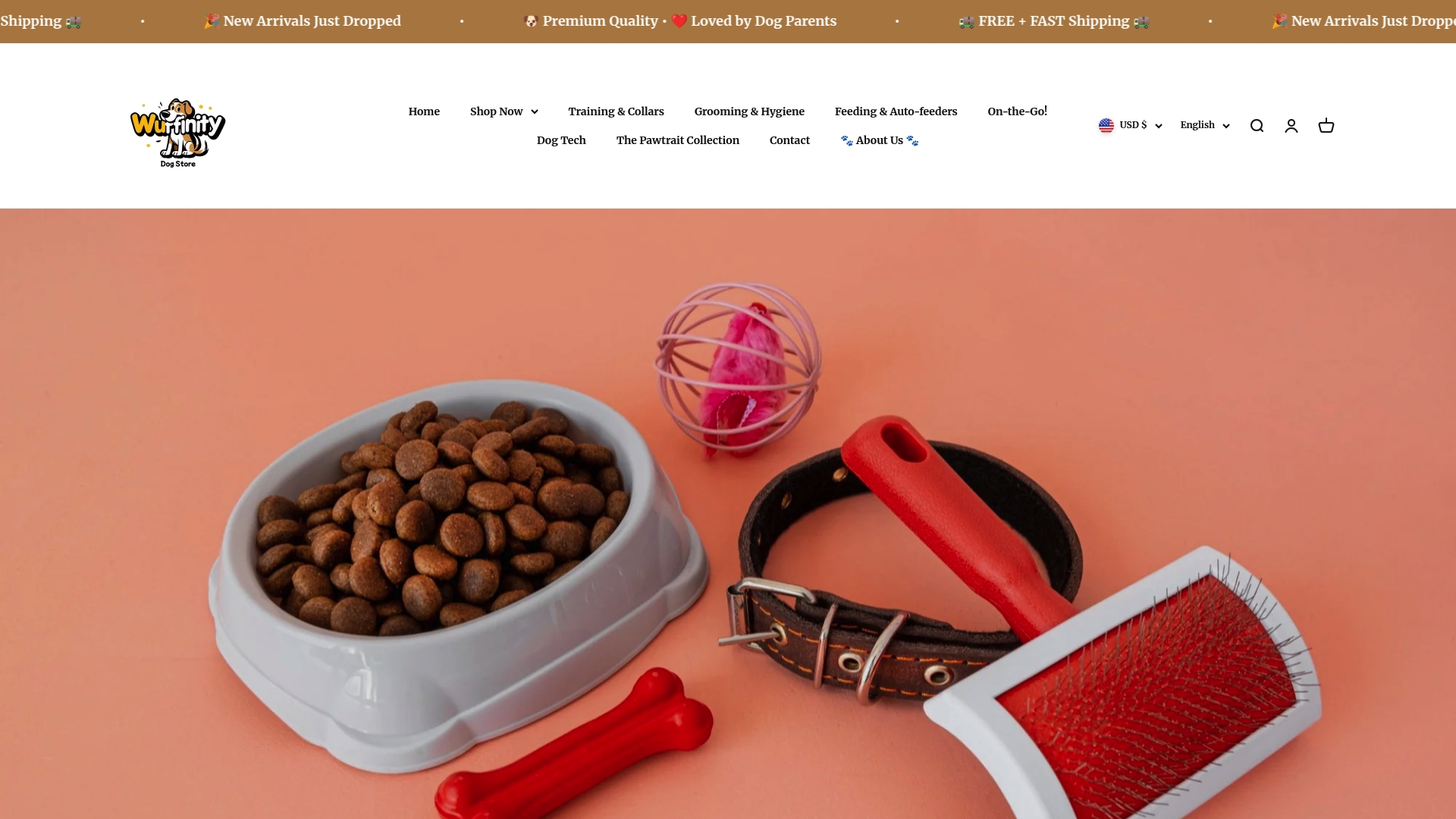Walking your dog should be simple, but the choice between a collar or harness can make all the difference. Over 60 percent of veterinarians recommend harnesses for dogs prone to neck injuries. Most people think a collar is fine for any breed, but research shows that picking the right harness changes your dog’s health and happiness in surprising ways.
Table of Contents
- What Is A Dog Harness And How Does It Differ From Collars?
- The Importance Of Safety And Comfort For Dogs
- Understanding The Benefits Of Using A Dog Harness
- How Dog Harnesses Enhance Training And Control
- Exploring Different Types Of Dog Harnesses And Their Uses
Quick Summary
| Takeaway | Explanation |
|---|---|
| Harnesses distribute pressure across the body | Unlike collars, harnesses spread strain to prevent neck and throat injuries. |
| Better control and steering during walks | Harnesses reduce pulling, allowing for improved management and guidance of your dog. |
| Safety first: harnesses minimize injury risks | Properly fitted harnesses protect against potential health issues for sensitive breeds. |
| Support emotional well-being for dogs | Comfortable harnesses reduce anxiety and promote calmness during walks or training. |
| Choose harnesses based on activity type | Different harness types serve specific purposes, enhancing safety and comfort across various situations. |
What is a Dog Harness and How Does It Differ from Collars?
A dog harness is a versatile and practical pet accessory designed to secure and support your canine companion during walks, training, and outdoor activities. Unlike traditional collars that encircle a dog’s neck, harnesses distribute pressure across the chest, shoulders, and back, providing enhanced control and comfort. Explore our guide on different dog harness types to understand the nuanced world of canine equipment.
Understanding Harness Basic Design
Harnesses are typically constructed from durable materials like nylon, leather, or mesh, featuring multiple adjustment points to accommodate various dog sizes and body shapes.
The primary design includes:
- A chest plate that wraps around the dog’s torso
- Adjustable straps that secure around the body
- Attachment points for leashes, typically located on the back or chest
Research from the American Veterinary Medical Association suggests that harnesses can significantly reduce strain on a dog’s neck, making them particularly beneficial for breeds prone to respiratory issues or neck injuries.
Key Differences Between Harnesses and Collars
While collars remain a traditional method of dog control, harnesses offer several distinctive advantages. Collars are simple neck rings that can potentially cause choking or tracheal damage if a dog pulls forcefully. In contrast, harnesses provide:

- Improved weight distribution: Spreads pressure across the body instead of concentrating it on the neck
- Better control: Reduces pulling and provides more steering capabilities
- Increased safety: Minimizes risk of neck injuries, especially for smaller or brachycephalic breeds
For dogs with specific needs like training, mobility challenges, or those with medical conditions, harnesses offer a more supportive and comfortable alternative to traditional collars. The design allows for better management of your pet’s movement while ensuring their physical comfort and safety during various activities.
To clarify the main structural and functional distinctions between harnesses and collars, the following table compares these two dog restraint styles across key attributes.
| Feature | Dog Harness | Dog Collar |
|---|---|---|
| Pressure Distribution | Spreads across chest and back | Concentrated on neck |
| Injury Risk | Minimizes neck/throat and spinal injuries | Can cause neck, tracheal injuries |
| Control Level | Greater steering, better for training and pulling management | Less control over pulling |
| Comfort for Dog | Generally more comfortable, less restrictive | Can cause discomfort, especially for sensitive breeds |
| Suitability for Special Needs | Ideal for dogs with respiratory, orthopedic, or mobility issues | Not recommended for fragile or injured dogs |
The Importance of Safety and Comfort for Dogs
Pet safety goes beyond simple protection, encompassing a comprehensive approach to your dog’s physical and emotional well-being. Choosing the right equipment, like a well-designed harness, plays a critical role in maintaining your dog’s comfort and preventing potential injuries. Explore our top dog safety products to understand how advanced accessories can transform your pet’s daily experience.
Physical Health and Injury Prevention
Dogs are active creatures with unique anatomical needs that require specialized equipment. Research from the Canine Health Foundation demonstrates that inappropriate restraint methods can lead to significant long-term health complications. Harnesses provide crucial benefits by:
- Distributing body weight evenly across the chest and back
- Reducing strain on sensitive neck and throat areas
- Minimizing potential spinal and tracheal damage during walks
For breeds prone to respiratory issues or with delicate neck structures, these considerations become even more paramount. A properly fitted harness acts like protective gear, significantly reducing the risk of accidental injury during regular activities.
Emotional Comfort and Behavioral Impact
Beyond physical safety, harnesses contribute profoundly to a dog’s emotional well-being. Dogs experiencing discomfort or pain can develop anxiety, stress, and behavioral challenges. A comfortable harness provides a sense of security and control, helping dogs feel more relaxed during walks and training. Positive restraint methods support better mental health, encouraging dogs to remain calm and responsive.
By prioritizing your dog’s safety and comfort through thoughtful equipment selection, you create an environment of trust and support. The right harness is not just an accessory but a critical tool in maintaining your pet’s overall quality of life, promoting both physical health and emotional stability.
Understanding the Benefits of Using a Dog Harness
Dog harnesses represent more than just a walking accessory they are an essential tool for responsible pet ownership. Learn the fundamental purpose of dog harnesses to appreciate their multifaceted benefits. These innovative restraint systems offer comprehensive advantages that go far beyond simple movement control.
Enhanced Control and Training Support
Harnesses provide superior management of your dog’s movement, particularly during training and outdoor activities. According to the Association of Professional Dog Trainers, harnesses create more balanced communication between dogs and owners. Key advantages include:
- Improved steering capabilities during walks
- Reduced pulling behavior through strategic design
- Greater stability for dogs with mobility challenges
The design allows trainers and pet owners to guide dogs more effectively without causing physical stress or discomfort.
 Precise body positioning enables more nuanced communication and helps establish better behavioral patterns.
Precise body positioning enables more nuanced communication and helps establish better behavioral patterns.
Health and Ergonomic Advantages
Modern dog harnesses are engineered with canine anatomy in mind, addressing critical physical health considerations. Research indicates that well-designed harnesses can significantly mitigate potential long-term health issues. The ergonomic benefits extend beyond immediate comfort:
- Distributes body weight evenly across the chest and shoulders
- Minimizes pressure on sensitive neck and throat regions
- Supports dogs with pre-existing medical conditions or physical limitations
For breeds prone to respiratory issues or those with delicate skeletal structures, harnesses offer a protective mechanism that traditional collars cannot match. By reducing strain and providing comprehensive support, these accessories contribute to overall canine wellness and longevity.
How Dog Harnesses Enhance Training and Control
Training a dog requires specialized equipment that supports both behavioral guidance and physical comfort. Discover different no-pull harness techniques to understand how strategic design can transform your training approach. Dog harnesses represent a sophisticated method of establishing communication and maintaining control during various training scenarios.
Behavioral Modification Techniques
Professional dog trainers recognize harnesses as powerful tools for behavioral intervention. According to the International Association of Canine Professionals, harnesses provide unique mechanical advantages that redirect and manage dog behavior more effectively than traditional collars. Strategic design elements support training objectives by:
- Providing immediate tactile feedback during movement
- Reducing reactive pulling behaviors
- Creating a more balanced walking experience
Precise body positioning allows trainers to guide dogs with minimal physical intervention, encouraging natural learning and cooperation. The harness becomes an extension of communication, helping dogs understand boundaries and expectations.
Advanced Control Mechanisms
Modern harnesses incorporate sophisticated control features that go beyond simple restraint. These designs focus on biomechanical principles that support both dog and handler during training sessions. Key control mechanisms include:
- Front-clip attachment points that discourage pulling
- Adjustable straps for customized fit and control
- Ergonomic designs that prevent uncomfortable pressure points
By distributing physical guidance across the dog’s body, harnesses minimize potential stress and create a more positive training environment. The result is a collaborative approach to learning that respects the dog’s physical and psychological well-being while maintaining necessary behavioral boundaries.
Exploring Different Types of Dog Harnesses and Their Uses
Dog harnesses are not one-size-fits-all accessories but sophisticated tools designed for specific purposes and canine needs. Learn about various dog belt configurations to appreciate the nuanced world of canine restraint systems. Understanding the diverse range of harness types can help pet owners make informed decisions about their dog’s comfort and safety.
Specialized Harness Categories
Veterinary research from the Canine Orthopedic Research Center highlights the importance of selecting appropriate harness designs for different dog breeds and activity levels. The primary harness categories include:
- Step-In Harnesses: Ideal for small dogs and those with limited mobility
- Back-Clip Harnesses: Perfect for well-trained dogs with minimal pulling tendencies
- Front-Clip Harnesses: Excellent for managing dogs with strong pulling behaviors
- No-Pull Harnesses: Specifically designed to discourage excessive pulling during walks
Structural variations play a crucial role in determining a harness’s effectiveness, with each design targeting specific training and mobility requirements.
Activity-Specific Harness Applications
Modern harnesses extend far beyond basic walking equipment, serving specialized functions across various environments. Different harness types are engineered to support specific activities:
- Car travel safety harnesses with crash-tested designs
- Outdoor hiking harnesses with additional attachment points for gear
- Service dog harnesses with reinforced handles and support structures
- Mobility assistance harnesses for dogs with physical limitations
By matching the harness to the specific activity and individual dog’s needs, owners can significantly enhance their pet’s comfort, safety, and overall movement experience.
To help you choose the right harness, this table outlines the primary types of dog harnesses mentioned in the article and their recommended uses.
| Harness Type | Description | Best For |
|---|---|---|
| Step-In Harness | Dog steps into, easy to put on | Small dogs, dogs with limited mobility |
| Back-Clip Harness | Leash attaches at back | Well-trained dogs, low pullers |
| Front-Clip Harness | Leash attaches at chest | Dogs with strong pulling tendencies |
| No-Pull Harness | Designed to discourage pulling | Training, active pullers |
| Travel Harness | Built for car safety | Car travel, crash protection |
| Hiking Harness | Extra attachment points for outdoor activities | Hiking, gear carrying |
| Service/Mobility Harness | Reinforced handles for assistance/support | Service dogs, dogs with mobility challenges |
| The right harness transforms from a simple restraint tool to a comprehensive support system tailored to unique canine requirements. |
Ready to Transform Your Walks With the Comfort and Safety of a Dog Harness?
If this article helped you understand how a harness can solve neck strain, control issues, and even behavioral stress for your dog, it’s time to act. You want to protect your pet from injury and discomfort while making every walk enjoyable. The right equipment is not just about style but a real step toward wellness and safety. Discover quality gear for every breed and lifestyle through our dog harness guide or visit our curated selection for top-rated, ergonomic solutions.

Give your best friend all the benefits discussed in this article today. Explore the latest dog harnesses and essentials at Wuffinity.store where trusted products meet easy shopping and fast shipping. Take control of your pet’s comfort and safety—shop now and notice the difference on your very next adventure.
Frequently Asked Questions
What are the benefits of using a dog harness instead of a collar?
Using a dog harness provides improved weight distribution across a dog’s body, increased control during walks, and enhanced safety that reduces the risk of neck injuries, especially for dogs that pull or have respiratory issues.
How do I properly fit a dog harness for my pet?
To properly fit a dog harness, measure your dog’s chest and neck circumference and follow the manufacturer’s sizing guide. The harness should be snug but allow for two fingers to fit between the harness and your dog’s skin to ensure comfort while preventing slipping.
Can using a harness help with dog training?
Yes, dog harnesses can aid in training by reducing pulling behavior and improving communication between the dog and owner. They provide greater control and comfort, making it easier to guide dogs during training sessions.
What types of dog harnesses are available, and how do I choose the right one?
There are several types of dog harnesses, including step-in, back-clip, front-clip, and no-pull harnesses. Choose one based on your dog’s specific needs and behavior, such as managing pulling tendencies or providing support for mobility challenges.






0 commentaire